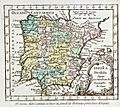Autonomous communities of Spain facts for kids
Spain is a country in Europe that is divided into 17 special parts called autonomous communities. Think of them like states in the United States, but they have their own unique powers. The word autonomous means "self-governing." This means each community has its own government, laws, and courts.
Spain also has 50 smaller areas called provinces. These provinces came together in 1978 to create the autonomous communities we know today. Some of these communities, like Catalonia, Basque Country, Galicia, and Andalusia, are known as "historic communities" because they were grouped together even before 1978.
Contents
Languages in Spain
Spanish is the main official language in almost all autonomous communities. However, in six of them, Spanish is shared with other languages:
- Catalonia: Catalan and Occitan are also official.
- Valencian Community: Catalan (also called Valencian here) is official.
- Balearic Islands: Catalan is also official.
- Galicia: Galician is also official.
- Basque Country: Basque is also official.
- Navarre: Basque is official, but mainly in the northern parts and near the Basque Country border.
List of Autonomous Communities and Their Capitals
Each autonomous community has a capital city. This is where its government offices are located.
- Andalusia (capital: Sevilla)
- Aragon (capital: Zaragoza)
- Asturias (capital: Oviedo)
- Balearic Islands (capital: Palma de Mallorca)
- Basque Country (capital: Vitoria)
- Canary Islands (two capitals: Las Palmas de Gran Canaria and Santa Cruz de Tenerife)
- Cantabria (capital: Santander)
- Castile-La Mancha (capital: Toledo)
- Castile and León (capital: Valladolid)
- Catalonia (capital: Barcelona)
- Extremadura (capital: Mérida)
- Galicia (capital: Santiago de Compostela)
- La Rioja (capital: Logroño)
- Community of Madrid (capital: Madrid)
- Region of Murcia (capital: Murcia)
- Navarre (capital: Pamplona)
- Valencian Community (capital: Valencia)
Special Cities in Africa
Spain also has two special cities on the northern coast of Africa: Ceuta and Melilla. These are called "autonomous cities." They have many of the same powers as an autonomous community, but they also act like provinces and regular cities at the same time.
Images for kids
-
A map of Iberia in 1757, showing how the region looked long ago.
-
The Parliament of Catalonia, or Parlament de Catalunya, in 2017.
-
The Conference of Presidents in 2017. This is a meeting where the Government of Spain (Gobierno de la Nación) meets with the leaders of all the autonomous communities.
-
The Regional Palace in Oviedo, which is the seat of the General Junta, the Parliament of the Principality of Asturias.
-
An Ertzaintza police car in the Basque Country. The Ertzaintza is the police force of the Basque Autonomous Community.
See also
 In Spanish: Comunidad autónoma para niños
In Spanish: Comunidad autónoma para niños









